
Jan van Belcamp (1610–1653) was a Flemish painter and copyist, active in England.

Jan van Belcamp (1610–1653) was a Flemish painter and copyist, active in England.
He was born in Antwerp but spent most of his career in England, where he was employed making copies of pictures in the Royal Collection. [1] According to his contemporary, Richard Symonds "this Belcamp was an under copier to another Dutchman, that did fondly keep the king's pictures and whenever any nobleman desired a copy, he directed them to Belcamp." [2] He also supplied the figures, probably copied from larger portraits, for A View of Greenwich (c.1632), painted by Adriaan van Stalbemt for Charles I and still in the Royal Collection. [3]
His paintings of Henry VII and Henry VIII, copied from a large picture by Holbein, later destroyed in a fire at Whitehall, were once at Drayton House in Northamptonshire. [1] There was also a collection of portraits copied by Belcamp at Wimpole Hall in Cambridgeshire. [4]
The "Great Picture" (1648; now in Abbot Hall Art Gallery in Kendal), a triptych showing the family of Lady Anne Clifford, which was formerly in Appleby Castle, has been attributed to van Belcamp. Many of the individuals shown were portrayed posthumously, using earlier portraits for reference. [5]
In 1649, following the execution of Charles I, Belcamp was appointed to the commission set up to sell the king's goods. [4] Belcamp presumably contributed valuations of the pictures. [6] Belcamp died in London; [1] Richard Symonds noted that he was recently dead in 1653. [4]

William Dobson was a portraitist and one of the first significant English painters, praised by his contemporary John Aubrey as "the most excellent painter that England has yet bred". He died relatively young and his final years were disrupted by the English Civil War.

Benjamin West was a British-American artist who painted famous historical scenes such as The Death of Nelson, The Death of General Wolfe, the Treaty of Paris, and Benjamin Franklin Drawing Electricity from the Sky.

John Maler Collier was a British painter and writer. He painted in the Pre-Raphaelite style, and was one of the most prominent portrait painters of his generation. Both of his marriages were to daughters of Thomas Henry Huxley. He was educated at Eton College, and he studied painting in Paris with Jean-Paul Laurens and at the Munich Academy starting in 1875.
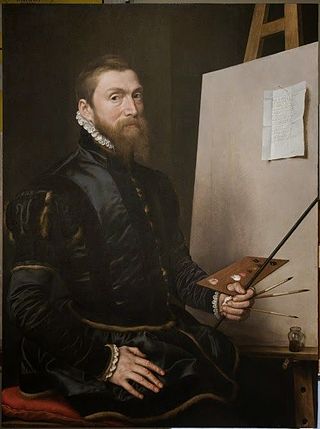
Anthonis Mor, also known as Anthonis Mor van Dashorst and Antonio Moro, was a Netherlandish portrait painter, much in demand by the courts of Europe. He has also been referred to as Antoon, Anthonius, Anthonis or Mor van Dashorst, and as Antonio Moro, António Mouro, Anthony More, etc., but signed most of his portraits as Anthonis Mor.

Willem van de Velde the Elder was a Dutch Golden Age seascape painter, who produced many precise drawings of ships and ink paintings of fleets, but later learned to use oil paints like his son.

Frank Cadogan Cowper was an English painter and illustrator of portraits, historical and literary scenes, also described as "The Last Pre-Raphaelite".

Hendrick Danckerts was a Dutch Golden Age painter and engraver, mostly of houses in their landscape settings. After some years in Italy, he spent most of his career in London, working for Charles II and his brother.
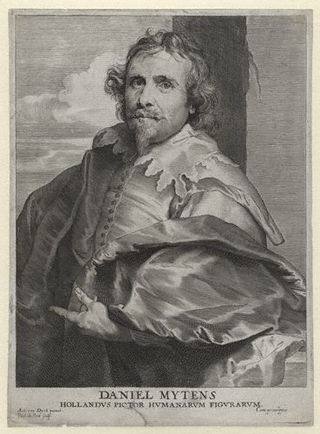
Daniël Mijtens, known in England as Daniel Mytens the Elder, was a Dutch Golden Age portrait painter belonging to a family of Flemish painters who spent the central years of his career working in England.
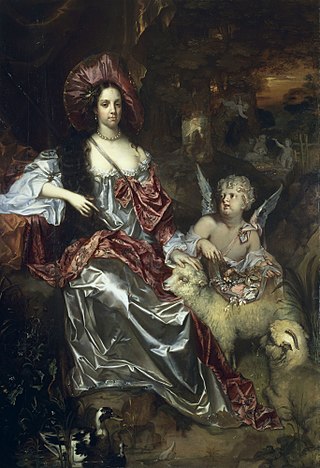
Jacob Huysmans was a Flemish portrait painter who, after training in his native Antwerp, immigrated to England before the Restoration. He became a feted court painter and attracted the patronage of the Portuguese born queen Catherine of Braganza, a Catholic like himself, of whom he painted several portraits. With his exuberant style, he was during his lifetime regarded as an important rival of the court painter Peter Lely who favored a more sober treatment of his sitters.
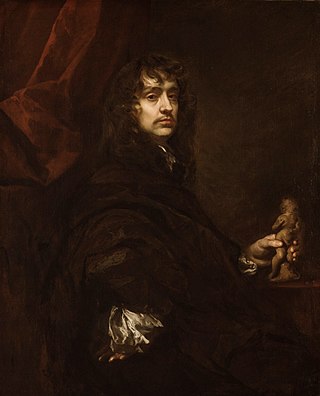
Sir Peter Lely was a painter of Dutch origin whose career was nearly all spent in England, where he became the dominant portrait painter to the court. He became a naturalised British subject and was knighted in 1679.

Paul van Somer, also known as Paulus van Somer, was a Flemish artist who arrived in England from Antwerp during the reign of King James I of England and became one of the leading painters of the royal court. He painted a number of portraits both of James and his consort, Queen Anne of Denmark, and of nobles such as Ludovic Stuart, Duke of Lennox, Elizabeth Stanley, Countess of Huntingdon, and Lady Anne Clifford. He is sometimes designated as "Paul van Somer I" to distinguish him from the engraver of the same name who was active in England between 1670 and 1694.
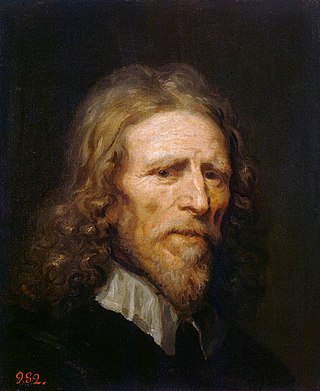
Abraham van der Doort was a Dutch artist. As Keeper of Charles I's art collections, he was the first Surveyor of the King's Pictures.

Adriaen Hanneman was a Dutch Golden Age painter best known for his portraits of the exiled British royal court. His style was strongly influenced by his contemporary, Anthony van Dyck.

Robert Peake the Elder was an English painter active in the later part of Elizabeth I's reign and for most of the reign of James I. In 1604, he was appointed picture maker to the heir to the throne, Prince Henry; and in 1607, serjeant-painter to King James I – a post he shared with John De Critz.
Jan Karel Donatus van Beecq was a Dutch marine painter, active in England and later in France, where he became a member of the Academy in 1681.

George Arnald was a British painter who specialised in landscapes, including topographical views to illustrated county histories. He is best known for his celebrated painting depicting the Battle of the Nile.

George Geldorp, Georg Geldorp or Jorge Geldorp was a Flemish painter who was mainly active in England where he was known for his portraits and history paintings. He was also active as an art dealer and impresario.
William Derby (1786–1847) was an English portraitist, miniature painter and copyist.
Jan Baptist Francken was supposed to be a painter from the Francken family and/or the son of Sebastian Vrancx, but is now considered to have been an error and to have never existed. The confusion was created by the many painters named Francken, some poor attributions, and a portrait by Anthony van Dyck of a certain Johannes Baptist Franck, aged 32, of whom nothing more is known. He is sometimes said to be the same as Hans Francken, another obscure member of the same family.

Remigius van Leemput, known in England simply as Remee, was a Flemish portrait painter, copyist, collector and art dealer mainly active in England. Together with another Flemish master painter from Antwerp, George Geldorp, he was the key collaborator of Anthony van Dyck during van Dyck's final stay in London.